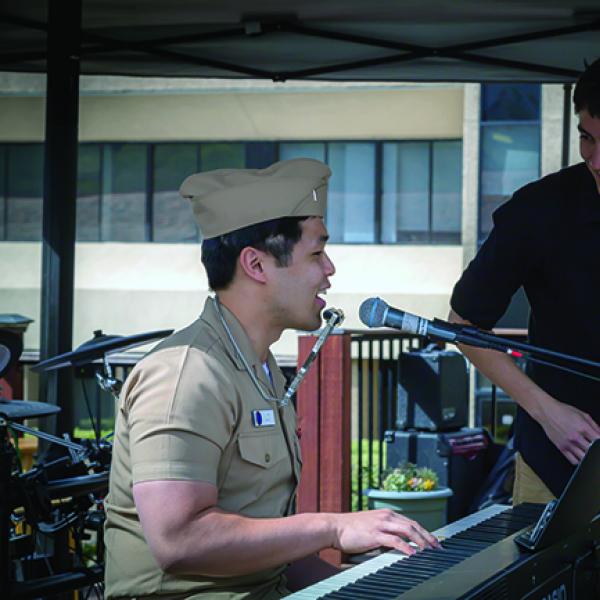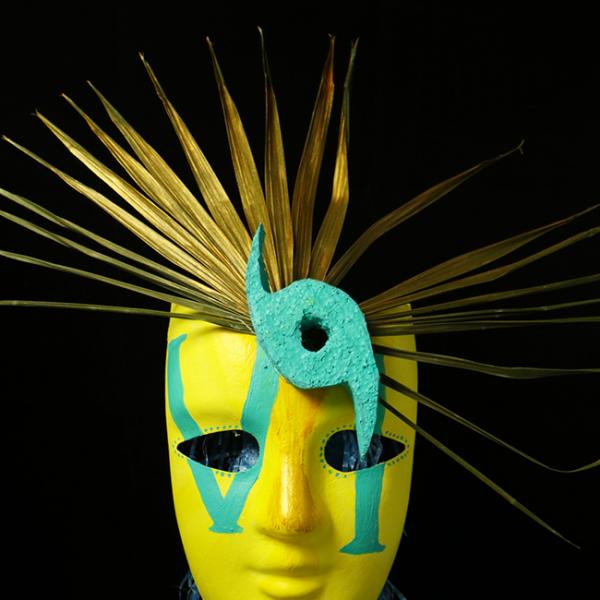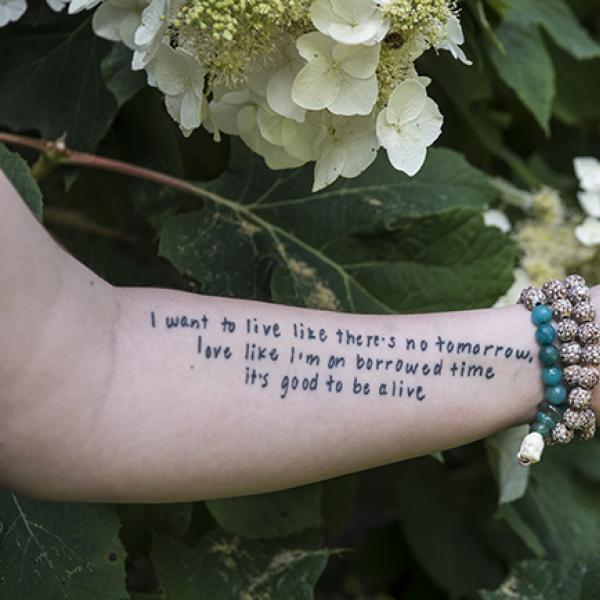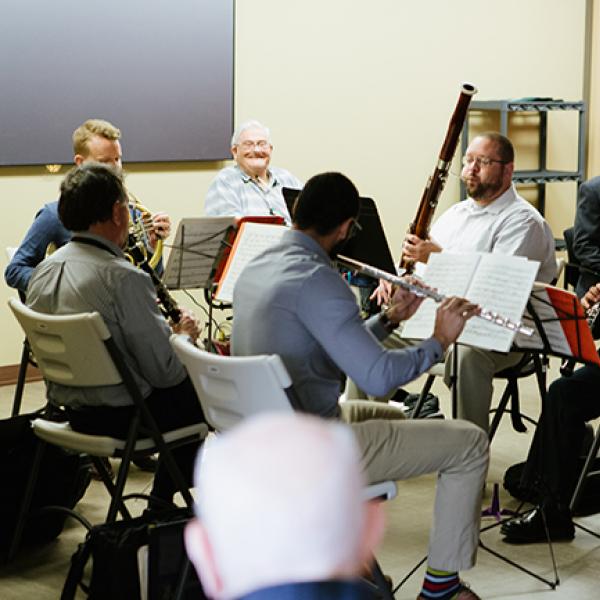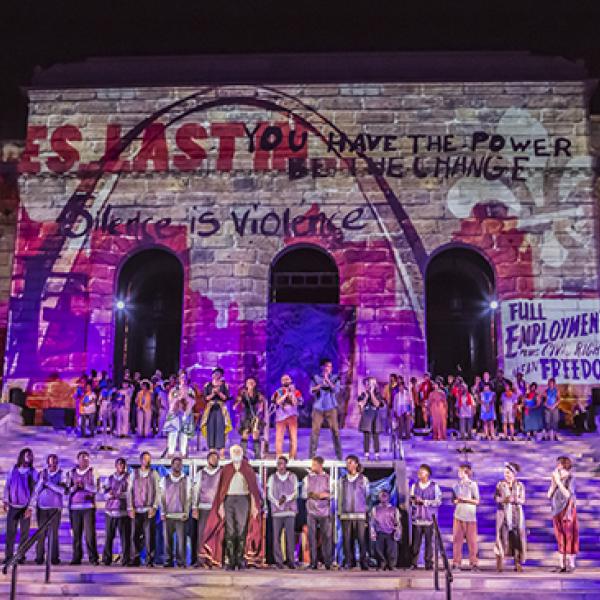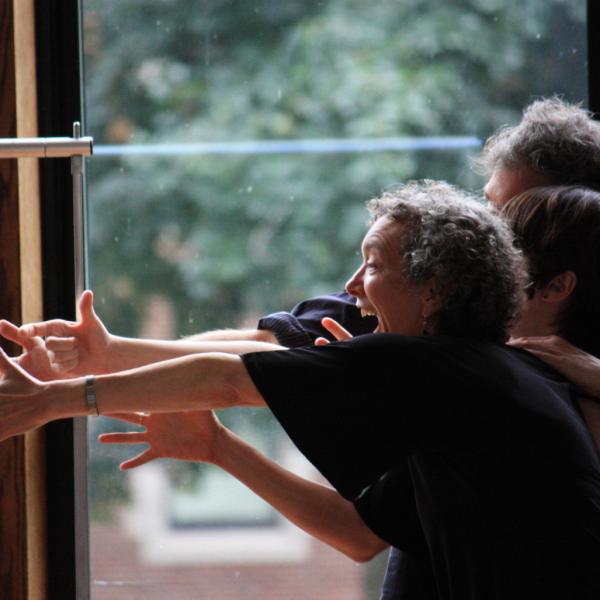Making Godzilla: An Audio Story About Producing a Video Story at Lurie Children’s Hospital of Chicago
Music under
Excerpt from workshop – sound of beeping machinery throughout in the hospital
John Lyons: Okay. And again, the action is both arms up at the same time?
Nicholas: And Godzilla, his is understandable.
John Lyons: All right. So is he where we want him to be?
Nicholas: Mm-hm.
Lyons: Okay.
Jon Stein: Okay, you want me just to hold him, and you do the--
Nicholas: I already did one thing--
Lyons: That's fine. Go ahead, go for it, yeah.
Jon Stein: Good eye, pointing out that my hand was in the shot.
Lyons: All right. Capture. Capture. They're going up together, right? Capture. Capture.
John Lyons: My name is John Lyons. I'm a teaching artist, filmmaker-in-residence at Lurie Children's Hospital in Chicago with Snow City Arts.
Adam Kampe: For about 15 years now, John Lyons has been making documentaries all over Chicago, and often with kids. In the clip at the start, you heard him working through a scene on a current project with fellow teaching artist advisor, Jon Stein, and godzilla superfan, the film’s director, a 15-year-old named Nicholas.
Nicholas: Godzilla was just this giant behemoth demon that seemed to be unstoppable.
AK: The three of them meet almost every thursday afternoon at Ann & Robert H. Lurie Children's Hospital of Chicago to shoot a film about Godzilla. a stop-motion film, where they have to take dozens of pictures of the same action or action figure and then edit the images together to create motion. Think of the old animated classic Rudolph the Red-Nosed Reindeer or a modern film like Wes Anderson’s Fantastic Mr. Fox. it’s painstaking work to say the least.
This is John Lyons’s second stint working with longtime NEA grantee, Snow City Arts, a nonprofit arts education organization that works with young people in four Chicago hospitals. Snow City provides bedside instruction and a much-needed creative outlet for kids who are too ill to attend school. They write poetry, they make music, they create visual art. In essence, Snow City’s workshops give these kids a break from their diagnosis.
Teaching artist advisor Jon Stein introduced John Lyons to Nicholas his first week on the job at Lurie Children's Hospital of Chicago.
John Lyons: He mentioned to me this young student that he'd been working with who was really into Godzilla, really into movies, and wanted to make a stop-motion film. And I think you should come with me and meet him and see what happens."
At first, I was just blown away by his knowledge and passion of the Godzilla universe. He knows every character, every film, every bit of trivia that you can possibly imagine, and knows the various versions that Godzilla has taken throughout the years.
In hospital room:
Nicholas: I didn’t start getting into the character aspect until I saw the second one I saw, which is GMK, which has Godzilla as this evil demon spirit and then him having to fight the three guardian monsters, which are Baragon, Mothra, and Ghidorah.
John Lyons: He is a really, really funny young man. He's irreverent. He is really, really goofy. He's always telling jokes. He's always trying to get us or his mom or nurses, especially, to laugh.
In the hospital room
Nicholas: My question is why is your head so bald?
John Lyons: Why is my head so bald? My head is so bald, because I think I work with you every week.
Nicholas: You don’t work with me every week, though, remember?
John Lyons: That’s why I’m not totally bald.
Nicholas: You are, you are—
John Lyons: It grows back in the weeks I don’t.
John Lyons: He is incredibly passionate about the stories he wants to tell. And so, the three of us, Jon and Nicholas and I, decided, "Well, let's start making a film."
Music up, under
Everybody in the hospital is there because of the students' diagnosis. We are there to make art with them, bringing a sense of empowerment into the room, walking in and saying, "You are now in charge of when I come and when I go and what we do, from beginning to end," and just that act alone regardless of if anything is made is incredibly powerful and meaningful.
And generally speaking, when I get into Lurie, which is usually 9:30 or 10:00, I shortly thereafter pop down, his room is a couple floors beneath our office, kind of pop down to just see how he's doing, see what's been up with his week. Nothing formal, nothing recorded, no equipment, just kind of saying, "Hey, how was your week?" and getting caught up, and then seeing what he's up to that day. And again, even though we have a very linear set of steps ahead of us to complete a film, we've got to get X-number of shots, we've got to edit X-number of scenes, it still is driven by him.
Back to hospital room
John Lyons: Is that what you were picturing?
Nicholas: Yeah.
John Lyons: Yeah, that’s a good shot.
Nicholas: What was Gamora doing to Turtle? With the arms up guy?
John Lyons: You still want to do that?
Nicholas: Yes. Only his arms move on the figure. Only his arms and tail move.
John Lyons: So his reaction is holding his arms up like, “Oh my gosh, I can’t believe this happened.”
Nicholas: Yeah. So can you see the shock.
John Lyons: If he's not feeling well or if he looks like he's getting tired or not feeling well, we can gauge that. If he's feeling a little bit more animated, as it were, and wanting to shoot, meaning there's a lot of action in the room and a lot of stuff going on, we shoot that day.
Music up
And every week, Nicholas brings a 2-square feet box full of Godzilla action figures.
John Lyons: Describe how you would take emotion and put it into a plastic toy that barely moves.
Nicholas: Well, they have different articulations like, they can move their arms and legs. And for some cases, like Baragon, he can move his ears up and down to show if he is sad or happy.
John Lyons: The very next week we started experimenting with how we'd set up the stop-motion set and where the iPad would go, where the set would go, where the monsters would go, and negotiating all of that within the confines of his room.
Back to the hospital room
Nicholas: We put the set on this table that the tape recorder is on, which I still want to knock over.
John Lyons: When we’re done.
Nicholas: And then the other tray table thing is what we put the camera on.
John Lyons: And you take pictures?
Nicholas: With my phone.
John Lyons: What shooting looks like with Nicholas, he does have some limited mobility, so until recently we had struggled with how to activate him in this very mobile process, right? So, we have the characters on his hospital table where his lunch is served. That all gets cleared off when we come in, and we put a foam-core backdrop with the scene on the back of the table as the background and we lay down a ground. We can remotely connect the app on the iPad to his phone so that he can get into whatever position is comfortable for him, look at what the iPad is showing, and actually capture the images one by one through his phone.
Jon Stein: So give us like one, two, three, we can establish him, and then start going quicker. Just hitting it.
John Lyons: There you go. So he's basically just raging.
Nicholas: Yeah. Because Rodan is one his best friends.
John Lyons: Keep going, keep going, and then, yeah, maybe he calms down and kind of just like collapses. Yeah.
Nicholas: Yeah
John Lyons: And while he's doing all that, he is directing Jon and I and whoever else is there to how the characters want to move. And it took some trial and error, and then we arrived at an ideal setup, and then we began playing around with different movements and different small scenes.
Back to hospital room
John Lyons: What’s next then?
Nicholas: Anguirus and his moving around frantically.
John Lyons: Do we still want to do that? And that was…
Nicholas: He was moving around frantically going “No” and his other leg is still bent backwards.
Sound of moving figures and camera
John Lyons: The reason he's there and the reason all of us are there is never really talked about. To the extent that it's brought up, it's when nurses come in and say, "Oh, it's time for this thing to happen with the IV or this thing to happen with whatever."
Jon Stein: No, go for it. Sorry, I didn't realize you were doing the temperature. Medical first. Movie-making second.
Nurse: I need my thermometer back. Godzilla's gonna get it.
John Lyons: I'm actually gonna flip it.
Nicholas: Godzilla already ate it.
Nurse: Oh, he already ate it. Want me to take that IV out, while you’re watching the movie?
Nicholas: Yeah.
John Lyons: What do you want people to know about you as a filmmaker?
Nicholas: I’m a very friendly guy.
John Lyons: What do you hope your film will do?
Nicholas: I hope my film will do good.
John Lyons: What does good mean, though?
Nicholas: If people start asking questions like “is there going to be another one?” or something, that’s usually when I feel like I’ve done good.
John Lyons: Okay.
John Lyons: Their access is limited while they're in the hospital. And like I said, the environment makes their whole existence centered around, orbit around their diagnosis, and Snow City and the work we do is kind of a check on that. And like I said, one of the favorite parts about the work we do is that when we walk in the door we are something different and we're putting them in charge and we're giving them a voice in a place where they really don't often have one, and so to give them that power and to empower them that way is really important to us and really meaningful to me as a teaching artist. Some of my most joyful days as a teacher have been in the rooms of these students at Snow City.
John Lyons: Is there anything else you want to add?
Nicholas: Godzilla so far has been a big part of my life.
John Lyons: Is there anything else you want to ask me or Jon?
Nicholas: Oh yeah, what’s your hopes on it? What are your hopes? What are you thinking?
John Lyons: My hopes?
Nicholas: Yeah.
John Lyons: My hopes are that we realize your vision.
Nicholas: And I have a question for you, as well.
John Lyons: Well, let me answer the first question you asked me. My hopes for the film are that we realize your vision and that we bring to life a script that you created. And if we do that, I’ll be happy. What’s your next question?
Nicholas: Can I knock this over? Can I knock this over now?
Music plays
AK: THAT WAS NICHOLAS AND ONE HIS TEACHING ARTISTS, JOHN LYONS, DISCUSSING THE EXPERIENCE OF MAKING A STOP MOTION FILM ABOUT GODZILLA. THIS IS A PROJECT OF SNOW CITY ARTS, A LONGTIME NEA ARTS ED GRANTEE. MANY THANKS TO JOHN LYONS FOR RECORDING HIMSELF AND PARTS OF HIS WORKSHOP WITH NICHOLAS. A BIG, WARM THANK YOU TO NICHOLAS FOR A) MAKING ART AND B) FOR LETTING US EAVESDROP ON HOW HE DOES IT. ALSO, THANKS TO ANN & ROBERT H. LURIE CHILDREN’S HOSPITAL OF CHICAGO. TO READ AND HEAR MORE STORIES ABOUT THE HEALING POWER OF ART, SEE THE LATEST ISSUE OF NEA ARTS AND FOLLOW OUR BLOG, ART WORKS. FOR THE NATIONAL ENDOWMENT FOR THE ARTS, I’M ADAM KAMPE.
MUSIC CREDITS:
Excerpts from the following songs used courtesy of Creative Commons and found on WFMU’s Free Music Archive, www.freemusicarchive.org.
“We Build with Rubber Bands” and “Children of Lemuel” by Blue Dot Sessions from the album, Lemuel.
“The Summit” by Blue Dot Sessions from the album, K2.
“Greylock” by Blue Dot Sessions from the album, Skittle.
And “Blipper” by Podington Bear from the album, Electronic II.


